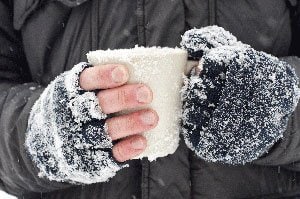Baby it’s cold outside!
Kevin Sirmons, MD, NRP
EMS Medical Director
CentraCare Health – Monticello
 The temperatures are forecast to be dangerously cold, which can increase the chances of developing cold injuries. As more cells in our bodies become frozen, similar to freezing water, they expand and the cell membranes stretch until they rupture. There are two kinds of injuries related to cold temperatures; chilblains and frostbite.
The temperatures are forecast to be dangerously cold, which can increase the chances of developing cold injuries. As more cells in our bodies become frozen, similar to freezing water, they expand and the cell membranes stretch until they rupture. There are two kinds of injuries related to cold temperatures; chilblains and frostbite.
Chilblains: Chronic exposure of bare skin to temperatures 32 to 60 degrees Fahrenheit. These appear as swollen, solid, raised bumps. Symptoms may include redness, burning and a prickly sensation. Treatment involves slow warming at room temperature, no rubbing and protecting the skin from trauma and secondary infection.
Frostbite: Frostbite causes longer lasting damage to the skin in varying degrees. These changes range from temporary (several minutes) of symptoms to longer lasting and more permanent damage.
Stages of frostbite
- First degree: partial freezing, superficial but no permanent damage. Skin looks red with mild swelling. Treatment is with immediate warming.
- Second degree: entire epidermal layer is frozen, and ruptured cells begin to ooze fluid, leading to blistering. Nerves are still intact, and the frostbite is still painful.
- Third degree: this is the stage where frostbite becomes painless. Loss of sensation (nerves in the dermal layer and below are destroyed). Yellowish, waxy skin. Tissue loss can be noted at this level.
- Fourth degree: Bluish, deeply aching areas; reddish discoloration 1-5 days after injury. Gangrene, tissue death, loss of digits. This stage of frostbite can lead to permanent anatomic and functional loss.
Treating frost bite
If you suspect frost bite, here are some tips of what to do, or not do when considering treating the injury:
- Warm immediately at temperatures slightly above body temperature.
- Warm with methods similar to the ways the body can get frostbite in the first place — convection with air, conduction with warming pads or warm running water, radiation with heaters nearby (watch for burning).
- Do not use dry heat such as stoves or campfires.
- Do not re-warm with exercise or rubbing the areas.
- Do not warm to the point that the skin is getting “pruny” — this can cause further damage to the skin in the immediate setting.
- Do not warm with scalding water. Frostbite and frostnip/chilblains are similar to burns — heat can cause further damage to the skin.
- Do not re-warm in the field if there is a risk of re-freezing. This can cause increased damage to the skin.
- Protect from further injury; pad all affected areas.
Read part two to learn how to prevent cold weather injuries.